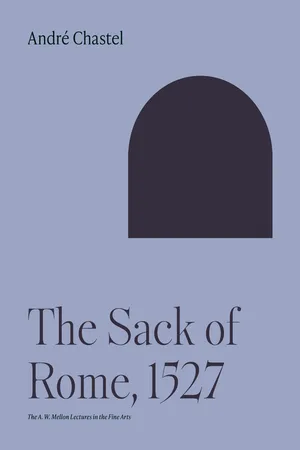
- 340 pages
- English
- PDF
- Available on iOS & Android
The Sack of Rome, 1527
About this book
From a leading art historian of Renaissance Italy, a compelling account of the artistic and cultural impact of the sack of sixteenth-century Rome
In this illustrated account of the sack of Rome as a cultural and artistic phenomenon, André Chastel reveals the historical ambiguities of preceding events and the traumatic contrast between the flourishing world of art under Pope Clement VII and the city after it was looted by the troops of Emperor Charles V in 1527. Chastel illuminates the cultural repercussions of the humiliation of Rome, emphasizing the spread or "Europeanization" of the Mannerist style by artists who fled the city—including Parmigianino, Rosso, Polidoro, Peruzzi, and Perino del Vaga. At the same time, Clement's critics used the new media of printing and engraving to win over the people with caricatures and satirical writings, while Rome responded with monumental works affirming the legitimacy of the pope's temporal power. Chastel explores both the world that was lost by the sack and the great works of art created during Rome's recovery.
Frequently asked questions
- Essential is ideal for learners and professionals who enjoy exploring a wide range of subjects. Access the Essential Library with 800,000+ trusted titles and best-sellers across business, personal growth, and the humanities. Includes unlimited reading time and Standard Read Aloud voice.
- Complete: Perfect for advanced learners and researchers needing full, unrestricted access. Unlock 1.4M+ books across hundreds of subjects, including academic and specialized titles. The Complete Plan also includes advanced features like Premium Read Aloud and Research Assistant.
Please note we cannot support devices running on iOS 13 and Android 7 or earlier. Learn more about using the app.
Information
Table of contents
- Cover
- Title
- Copyright
- Contents
- List of Illustrations
- List of Maps
- Photographic Sources
- Introduction
- I. Misera Caput Mundi
- II. Rome — Babylon
- III. Urbis Direptio
- IV. Polemics : Italians And Barbarians
- V. The Clementine Style
- VI. Papal Redress, Imperial Triumph
- Epilogue
- Notes
- Bibliography
- Index